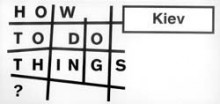A fervent Euro-centrist sometimes finds life rather difficult. On the one hand, integrating into the Old World is undoubtedly a good thing to do, but on the other, this movement produces some very odd results in culture, giving birth to what may be called integrative style. One example of this style is the exhibit “How to Do Things? In the Middle of (No)where” held at Kyiv’s Contemporary Art Center on Kontraktova ploshcha.
According to the center’s press release, the exhibit is part of a more ambitious project involving 28 artists from 14 European countries, including such dissimilar ones as Germany, Hungary, France, Belarus, Slovenia, Denmark, Ukraine, and the Netherlands. For one month young artists will be working and living in residential studios in Kyiv, Copenhagen, Budapest, Bucharest, and Berlin, reflecting the results of their long sojourns on their canvases.
The majority of the exhibit consists of filmed images typical of such events: videos and one slide-film. Bik van der Pol (the Netherlands) presents his video reports on a visit to a semi-secret nuclear testing ground in the US. His 90-minute-long video is entitled Trinity, New Mexico. April 2, 2005: it shows relaxed tourists roaming around a scorched desert to the accompaniment of upbeat songs about radioactive contamination.
Judith Hopf, Natascha Sadr-Haghighian, and Florian Zeyfang chose a safer place, chilly Venice, to do some shooting at the famous Giardini Napoleonici, the garden that hosts the Biennale, the world’s oldest biannual festival of modern art. Their joint efforts resulted in Proprio Aperto, a show of empty exhibition halls and alleys littered with fallen leaves accompanied by the authors’ off-screen comment. The American Sean Snider took the greatest risks by shooting his video composition (also voiced- over) Cassio, Seiko, Sheraton, Toyota, Mars in beleaguered Baghdad.
The collection of 81 dichromatic photographs, entitled “Darkness - Kyiv Slides,” Zeyfang is truly superb. At first glance, these photos, taken on Kyiv’s streets, appear lackluster and very restrained in terms of both material and execution. However, Zeyfang has a gift for revealing the true poetry in these seemingly unpretentious faces, streets, and landscapes. Even though the slides with subtitles in two languages are fragmentary and often bombastic, they correlate to the video footage and constantly evoke new meanings.
The other artists in this exhibit seem to have been driven by the desire to be radical at any cost. “Fluorescence/Shadows of the Forgotten Ancestors” by Roman Dziadkiewicz (Poland) was supposed to include several icons (“Fire, or In Search of a Golden Tooth,” “Air, or Revelations in the Light of a Film,” “Water, or Reflection of the Devil,” and “Earth, or Malewicz’s Unbounded Unity”). But, of course, there was nothing but an explanation printed out in foolscap size.
Another work by the same artist, displayed on a nearby table, consists of the text of a petition to the city mayor, requesting that Kyiv’s municipal garbage dump be named after Kazimierz Malewicz. Visitors are eagerly signing the appeal.
The Hungarian-French art association, Societe Realiste, also confined itself to texts. Their display board invites visitors to participate in the commercial game “Ponsis.” But it is difficult to understand the rules of this game unless you have a specialized financial education, and this part of the exhibit is not causing much of a stir. This is what average European art looks like: some video, some photography, a little bit of commerce, and a lot of orderly trash. This is neither good nor bad. The point is the look, not the material. It is the intensity of a look that determines, among other things, the degree of talent. Apart from one exception, the exhibit, “How to Do Things? In the Middle of (No)where,” seems to be the realm of the distracted and inattentive glance, the glance of someone who wants to consume everything instantly, i.e., an individual who does not want or is unable to give, although giving is the very basis of any art.








